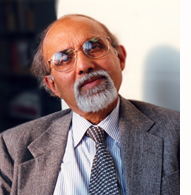

When Sanjoy Mitter arrived at MIT in the late summer of 1969, LIDS—then known as the Electronic Systems Laboratory—was still a part of the Institute’s department of Electrical Engineering. The research group had already been the source of several foundational texts in control theory, but it was a lab in transition, shifting in scope as the field of control theory expanded.
As of this year, Sanjoy has spent four decades with MIT and LIDS. Over that time, the lab has grown in size and prominence, and Sanjoy, who served as director or co-director of the lab for nearly two decades, helped LIDS keep pace with the rapid increase of knowledge in information technology and theory. He’s served as director of the Center for Intelligent Control Systems—a collaborative effort that united researchers from MIT, Harvard, and Brown. In the late seventies and eighties, Sanjoy worked to understand “the relationship between the mathematical structure underlying quantum physics and non-linear filtering theory,” and wrote a paper on the subject, which he considers one of the biggest contributions of his career. He has helped advance estimation and filtering theory and been the recipient of several major awards, including the Richard E. Bellman Control Heritage award for his contributions to the theory of automatic control.
But when Sanjoy looks back on his career thus far, he speaks most readily about collaborating with students and colleagues and how seeking answers to big theoretical problems could shape the future. LIDS, Sanjoy says, is a “very human place” and even seemingly abstract theoretical pursuits are continually interwoven with real world applications.
Most recently, says Sanjoy, he’s been working on unifying the fields of communication and control. The unified view is essential to understand the emerging of Control over Networks. It is associated with the implementation of smart electrical grids, and Sanjoy is working with Professors Munther Dahleh, Dimitri Bertsekas and Asu Ozdaglar. It’s likely that renewable energy sources—like wind and solar power—will be increasingly valuable as the world’s supply of fossil fuels continues to dwindle. But our ability to use those energy generation methods is limited by their inconsistent performance. Most renewable energy sources are intermittent—when sunlight doesn’t strike solar panels and wind doesn’t turn turbines, the power goes out. A self-regulating “smart” electrical grid could compensate for that inconsistent supply, redirecting power from one source to compensate for a lapse in another.
But this type of system—a smart grid that relies on sensing technology to send signals through communication channels to controllers that adjust how power is distributed, all without human oversight—is subject to the limitations of communication and control, and those theoretical limitations are currently unknown. So Sanjoy and his colleagues have been working to understand the theoretical edges of these systems.
Theory can also enable applications on a medical level, as Sanjoy’s work with one of his former PhD students, Lakshminarayan Srinivasan, shows. As a student, Sanjoy says, Lakshminarayan was interested in understanding how spatial information is stored in the brain. Everything that we see—the shape of the letters printed here, the size of the paper you’re looking at, the width of the margin—is recorded as electrical signals that are stored in the brain. But what is the nature of that coding? How is that information stored and processed? The answer to that question could provide researchers with a way of creating neural prosthetics that can understand neural signals and translate those signals in the body, when the pathway is otherwise blocked because of injury or neurodegenerative disease. “What you’d like to do,” Sanjoy says, “is implant some prosthetic device in the brain and generate those signals to try to electronically control the appropriate part of the brain.” Lakshminarayan is now a Neurosurgery research fellow at the Center for Nervous System Repair at Massachusetts General Hospital.
Theory may sound abstract and dry to the layperson, but Sanjoy’s description paints a portrait of a dynamic work environment filled with passionate researchers. Collaboration between professors, students and post-doctoral researchers is commonplace, and Sanjoy works to create a nurturing environment for his students that will let them develop into independent investigators.
“I’m very proud of the graduate students I’ve been fortunate to supervise over my career,” says Sanjoy. “We pay a lot of attention to the fact that students should make their own choice of research problems. The whole process of choosing a research problem is a very important thing,” he pauses, “maybe the most important thing. I interact with [my students] quite closely but give them adequate freedom... There aren’t specific tasks that the students have to fulfill. It’s much more free and open.”
Over the years, Sanjoy’s collaborations have taken him across the globe and he’s spent considerable time as a visiting professor at universities in Italy, India, and elsewhere. He’s learned much from his travels, made strong personal connections with his collaborators and attracted talented students to MIT through his teaching. Although traveling has been stimulating and fruitful, Sanjoy says he still prefers the academic atmosphere of his home university.
“I think the intellectual atmosphere that this area offers—not just MIT, but Harvard, Brown, and other universities—would be difficult to find elsewhere,” he says.
